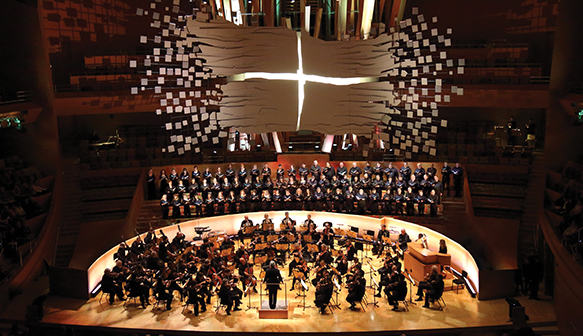
RARIFIED ATMOSPHERE OF ‘MISSA SOLEMNIS’
Bold Semi-Staged ‘ThomasSolemnis’ at S.F. Symphony
The audacity of Music Director Michael Tilson Thomas is astounding, bordering on a touch a genius, as he dared to mount a semi-staged performance of Beethoven’s great Latin mass, the Missa Solemnis. It turned a church concert into a grand and vibrant spectacle at Davies Hall, which had to be reconfigured mightily to adapt to unaccustomed theatrical flashpoints.
Controversy will surround this venture, of course, just as past stagings of church works like the Bach “St. Matthew Passion” and the Fauré Requiem in this area have evoked. But this venture, doubtless to be dubbed the “ThomaSolemnis,” is profound and devout, permitting grasping of this intimidating work on a deeper emotional and philosophical level, before a broader audience. Coming out of the S.F. Symphony & Chorus concert June 10, I was unsure whether HE was now a true believer, or I, or both.
MTT took the unprecedented step of personally penning a 2,000-word analysis of the music in the program. The projections of designer Finn Ross played on a giant screen, sometimes with myriad alphabets tumbling and rolling around space, as if stars in colliding galaxies, and sometimes giving way to stylized, oblique sketches of crosses and the dying Christ. MTT refers to this expansive treatment as “visualization” (of the music).
The three choruses became central players, and the four vocal soloists roving actors in the (rather gratuitous) walking choreography of Stage Director James Darrah intended to provide some theatrical mobility. Spatial music entered in when trumpets and drums on high summoned terrestrial souls to the firmament. The whole was to give mobility to a grand work lacking arias, and offering just two isolated solos for bass and for violin.
And the hundreds of lights and scenes above served to open up the celestial sphere receiving the supplications and supplicants from down below. The piece became multi-dimensional, but without subverting the music. The effect where I sat was altogether electric.
All the changes were intended to draw one and all INTO the performance instead of just standing on the sidelines listening. The message was more powerful than ever before, though purists surely shuddered.
And, if there was any doubt, the public became the central protagonist for the message of salvation; when the klieg lights bore down on me, it was like the arrival of The Last Judgment. (Ready, everybody??)
None of this of course is indicated in Beethoven’s great 71-minute score that took four long years to write, and finished just three years before his death. What would his reaction be to such a semi-staging?
His own fervor was a burning one, underlined by his insistent repetitions of text: “Gloria, gloria,” and “Credo, credo!” Musically, he takes us in many directions, writing at times in the manner of Bach, Handel or Mozart, and emphasizing counterpoint, never sheer virtuosity.
He also demanded near-superhuman commitment by performers, especially the choristers. Any chorister will tell you, Beethoven’s elevated tessitura is almost out of reach of a merely human voice.
The cast was strong. Among the striking solos, bass-baritone Shenyang carressed the adulatory “Lamb of God” as one of the faithful, while Concertmaster Alexander Barantschik rendered the reverent obbligato of the Benedictus. Of the vocal soloists, the most stirring was the robust operatic tenor Brandon Jovanovich, rarely heard in orchestral engagements.
The SFS Chorus was divided into large and small ensembles, abetted by the Pacific Boychoir—over 140 singers all told. MTT conducted with both reverence and precision, reseating the violins into antiphonal placement. There was no intermission, and there was a notable pause at the end—A public deeply moved, and trying to catch collective breaths. This was one of the most remarkable and astonishing achievements of the two-decade MTT tenure to date.
It is performed without intermission.
These San Francisco Symphony concerts continue through June 13 at 8 p.m. For info: (415) 864-6000, or go online. Broadcasts on KDFC-FM (90.3 and others) at 8 p.m. on the second Tuesday following.
©Paul Hertelendy 2015
#
Paul Hertelendy has been covering the dance and modern-music scene in the San Francisco Bay Area with relish — and a certain amount of salsa — for years.
These critiques appearing weekly (or sometimes semi-weekly, but never weakly) will focus on dance and new musical creativity in performance, with forays into books (by authors of the region), theater and recordings by local artists as well.
#